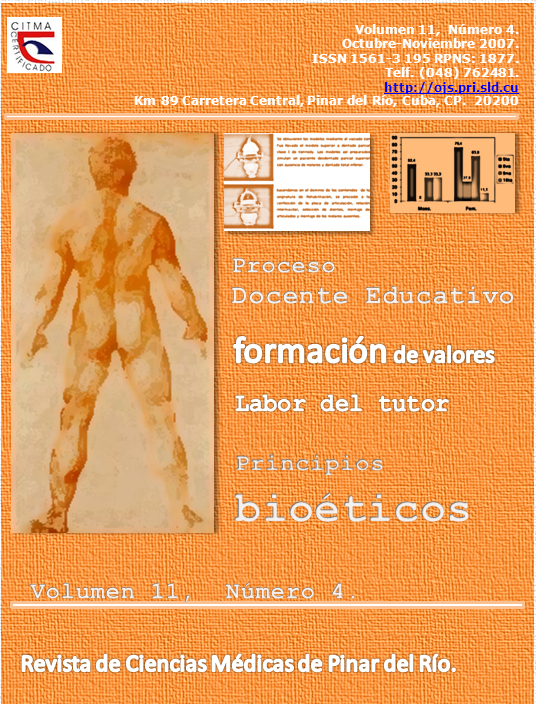Propuesta metodológica de una clase en educación en el trabajo / A methodological proposal for a lecture about "Education in Work"
Abstract
La contradicción fundamental, en el objeto de la Didáctica se presenta entre las exigencias que la sociedad plantea en la enseñanza y el nivel alcanzado por los estudiantes en un momento dado durante su aprendizaje. La solución de esta contradicción es el motor impulsor de este proceso. En aras de contribuir con él, nuestro objetivo fue mostrar una propuesta metodológica de una clase en educación en el trabajo en la formación del Especialista en Estomatología General Integral. En el contenido del programa analítico, están bien establecidos los objetivos por año académico y por módulos, no así por temas. Para elaborar el objetivo temático se tuvo en cuenta su función: lograr transformaciones graduales en los sistemas de conocimientos y habilidades de los residentes, así como en sus actitudes, convicciones, sentimientos, ideales y valores. Se prestó gran atención a los métodos problémicos, así como al método clínico en su dimensión didáctica. Este enfoque favorece el paradigma educacional actual de aprender a aprender y de aprender haciendo bajo la conducción del que enseña. Se elaboró un sistema de tareas docentes. Esta tarea constituye un modo de concretar el objeto de estudio. Estimula independencia cognoscitiva, individualidad creadora, integridad, carácter consciente y activo. Se concluye que el asumir esta premisa aumentó la responsabilidad del profesor en cuanto a pensar en términos de objetivo, de manera tal que permita al residente ir más allá de un mero aprender de asociaciones, a un generar de ideas propias.
Palabras clave: APRENDIZAJE, ODONTOLOGÍA COMUNITARIA.
ABSTRACT
The main contradiction in the object of Didactics is between the demands the society establishes in learning and the level students achieve at a given moment along the teaching-learning process. The solution for this contradiction is the motivation of this process. For the purpose of contributing to this process, a methodological proposal for a lecture about " Education in Work " was created to form Comprehensive Specialists in Dentistry. In the content of this analytic syllabus the objectives are properly set up per academic years and modules, but not per themes. The thematic objective was created taking into account its function: to achieve gradual transformations in the systems of knowledge and skills in residents; as well as in the attitudes, convictions, feelings, ideas and values. Problematic methods were carefully observed and a clinical method was analyzed from a didactic point of view. This approach favours current educational paradigm - learning to learn and learning doing - under the guide of whoever teaches. A system of teaching tasks was prepared. These tasks constitute a way to pinpoint the object of study. It motivates cognitive independence, a creative individual, integrity, active and conscious character. Concluding that, when this approach was adopted, professor's responsibility towards thinking of objective terms increased, allowing this way , that the residents in the specialty go beyond learning through associations to create own ideas.
Key words: LEARNING, COMMUNITY DENTISTRY
Downloads
How to Cite
Issue
Section
License
Authors who have publications with this journal agree to the following terms: Authors will retain their copyrights and grant the journal the right of first publication of their work, which will be publication of their work, which will be simultaneously subject to the Creative Commons Attribution License (CC-BY-NC 4.0) that allows third parties to share the work as long as its author and first publication in this journal are indicated.
Authors may adopt other non-exclusive license agreements for distribution of the published version of the work (e.g.: deposit it in an institutional telematic archive or publish it in a volume). Likewise, and according to the recommendations of the Medical Sciences Editorial (ECIMED), authors must declare in each article their contribution according to the CRediT taxonomy (contributor roles). This taxonomy includes 14 roles, which can be used to represent the tasks typically performed by contributors in scientific academic production. It should be consulted in monograph) whenever initial publication in this journal is indicated. Authors are allowed and encouraged to disseminate their work through the Internet (e.g., in institutional telematic archives or on their web page) before and during the submission process, which may produce interesting exchanges and increase citations of the published work. (See The effect of open access). https://casrai.org/credit/



